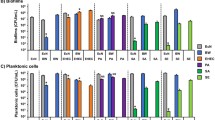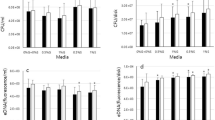Abstract
Extraintestinal pathogenic Escherichia coli (ExPEC) is an important zoonotic and foodborne pathogen. Biofilms are specially structured communities for bacteria to survive in different hostile environments and can protect the bacteria from eradication by the host and external factors. In this study, we found that oxygen is definitely required for biofilm formation in ExPEC strain PPECC42. Aerobically growing ExPEC showed a bdar (brown, dry, and rough) morphotype, whereas anaerobically growing ExPEC showed a saw (smooth and white) morphotype. Under anaerobic condition, curli fimbriae did not accumulate and the expression levels of curli biosynthesis-related genes including csgB, csgD, and rpoS decreased significantly; in contrast, the expression level of h-ns, of which the encoding protein is a repressor for csgD transcription, increased significantly. Taken together, the results suggested that oxygen-free condition limited ExPEC strain PPECC42 biofilm formation mainly through preventing curli accumulation by affecting the transcriptional levels of curli biosynthesis-related genes.



Similar content being viewed by others
References
Ahn S-J, Burne RA (2007) Effects of oxygen on biofilm formation and the AtlA autolysin of Streptococcus mutants. J Bacteriol 189:6293–6302
Aslam M, Toufeer M, Bravo CN, Lai V, Rempel H, Manges A, Diarra MS (2014) Characterization of extraintestinal pathogenic Escherichia coli isolated from retail poultry meats from Alberta, Canada. Int J Food Microbiol 177:49–56
Bachmann BJ (1996) Derivations and genotypes of some mutant derivatives of Escherichia coli K-12. In: Escherichia coli and Salmonella: cellular and molecular biology, 2nd edn. ASM Press, Washington, pp 2460–2488
Barnhart MM, Chapman MR (2006) Curli biogenesis and function. Annu Rev Microbiol 60:131–147
Beloin C, Roux A, Ghigo J-M (2008) Escherichia coli biofilms. Curr Top Microbiol Immunol 322:249–289
Bokranz W, Wang X, Tschäpe H, Römling U (2005) Expression of cellulose and curli fimbriae by Escherichia coli isolated from the gastrointestinal tract. J Med Microbiol 54:1171–1182
Burmølle M, Thomsen TR, Fazli M, Dige I, Christensen L, Homøe P, Tvede M, Nyvad B, Tolker-Nielsen T, Givskov M (2010) Biofilms in chronic infections–a matter of opportunity–monospecies biofilms in multispecies infections. FEMS Immunol Med Microbiol 59:324–336
Colón-González M, Méndez-Ortiz MM, Membrillo-Hernández J (2004) Anaerobic growth does not support biofilm formation in Escherichia coli K-12. Res Microbiol 155:514–521
Costerton J, Stewart PS, Greenberg E (1999) Bacterial biofilms: a common cause of persistent infections. Science 284:1318–1322
de la Fuente-Núñez C, Reffuveille F, Fernández L, Hancock REW (2013) Bacterial biofilm development as a multicellular adaptation: antibiotic resistance and new therapeutic strategies. Curr Opin Microbiol 16:580–589
Ding Y, Tang X, Lu P, Wu B, Xu Z, Liu W, Zhang R, Bei W, Chen H, Tan C (2012) Clonal analysis and virulent traits of pathogenic extraintestinal Escherichia coli isolates from swine in China. BMC Vet Res 8:140
Hall-Stoodley L, Costerton JW, Stoodley P (2004) Bacterial biofilms: from the natural environment to infectious diseases. Nat Rev Micro 2:95–108
Handt LK, Stoffregen DA, Prescott JS, Pouch WJ, Ngai DT, Anderson CA, Gatto NT, DebRoy C, Fairbrother JM, Motzel SL (2003) Clinical and microbiologic characterization of hemorrhagic pneumonia due to extraintestinal pathogenic Escherichia coli in four young dogs. Comp Med 53:663–670
Hou B, Meng XR, Zhang LY, Tan C, ** H, Zhou R, Gao JF, Wu B, Liu M, Li ZL, Chen HC, Bi DR, Li SW (2014) TolC promotes ExPEC biofilm formation and curli production in response to medium osmolarity. Biomed Res Int. doi:10.1155/2014/574274
Johnson JR, Delavari P, O’Bryan TT, Smith KE, Tatini S (2005) Contamination of retail foods, particularly turkey, from community markets (Minnesota, 1999–2000) with antimicrobial-resistant and extraintestinal pathogenic Escherichia coli. Foodborne Pathog Dis 2:38–49
Jubelin G, Vianney A, Beloin C, Ghigo J-M, Lazzaroni J-C, Lejeune P, Dorel C (2005) CpxR/OmpR interplay regulates curli gene expression in response to osmolarity in Escherichia coli. J Bacteriol 187:2038–2049
Livak KJ, Schmittigen TD (2001) Analysis of relative gene expression data using real-time quantitative PCR and the 2(-delta delta C(T)) method. Methods 25:402–408
Lyhs U, Ikonen I, Pohjanvirta T, Raninen K, Perko-Mäkelä P, Pelkonen S (2012) Extraintestinal pathogenic Escherichia coli in poultry meat products on the Finnish retail market. Acta Vet Scand 54:64
Manges AR, Johnson JR (2012) Foodborne origins of Escherichia coli causing extraintestinal infections. Clin Infect Dis 55:712–719
Mellata M (2013) Human and avian extraintestinal pathogenic Escherichia coli: infections, zoonotic risks, and antibiotic resistance trends. Foodborne Pathog Dis 10:916–932
Mitchell NM, Johnson JR, Johnston B, Curtiss R 3rd, Mellata M (2015) Zoonotic potential of Escherichia coli isolates from retail chicken meat products and eggs. Appl Environ Microbiol 81:1177–1187
Notley-McRobb L, King T, Ferenci T (2002) rpoS mutations and loss of general stress resistance in Escherichia coli populations as a consequence of conflict between competing stress responses. J Bacteriol 184:806–811
Olsén A, Arnqvist A, Hammar M, Sukupolvi S, Normark S (1993) The RpoS sigma factor relieves H-NS-mediated transcriptional repression of csgA, the subunit gene of fibronectin-binding curli in Escherichia coli. Mol Microbiol 7:523–536
Omadjela O, Narahari A, Strumillo J, Mélida H, Mazur O, Bulone V, Zimmer J (2013) BcsA and BcsB form the catalytically active core of bacterial cellulose synthase sufficient for in vitro cellulose synthesis. Proc Nat Acad Sci USA 110:17856–17861
Platell JL, Cobbold RN, Johnson JR, Heisig A, Heisig P, Clabots C, Kuskowski MA, Trott DJ (2011) Commonality among fluoroquinolone-resistant sequence type ST131 extraintestinal Escherichia coli isolates from humans and companion animals in Australia. Antimicrob Agents Chemother 55:3782–3787
Römling U (2001) Genetic and phenotypic analysis of multicellular behavior in Salmonella typhimurium. Method Enzymol 336:48–59
Scher K, Romling U, Yaron S (2005) Effect of heat, acidification, and chlorination on Salmonella enterica serovar Typhimurium cells in a biofilm formed at the air–liquid interface. Appl Environ Microbiol 71:1163–1168
Smith JL, Fratamico PM, Gunther NW (2007) Extraintestinal pathogenic Escherichia coli. Foodborne Pathog Dis 4:134–163
Steenackers H, Hermans K, Vanderleyden J, De Keersmaecker SC (2012) Salmonella biofilms: an overview on occurrence, structure, regulation and eradication. Food Res Int 45:502–531
Sunagawa N, Tajima K, Hosoda M, Kawano S, Kose R, Satoh Y, Yao M, Dairi T (2012) Cellulose production by Enterobacter sp. CJF-002 and identification of genes for cellulose biosynthesis. Cellulos 19:1989–2001
Sura R, Van Kruiningen H, DebRoy C, Hinckley L, Greenberg K, Gordon Z, French R (2007) Extraintestinal pathogenic Escherichia coli-induced acute necrotizing pneumonia in cats. Zoonoses Public Health 54:307–313
Tan C, Tang X, Zhang X, Ding Y, Zhao Z, Wu B, Cai X, Liu Z, He Q, Chen H (2012) Serotypes and virulence genes of extraintestinal pathogenic Escherichia coli isolates from diseased pigs in China. Vet J 192:483–488
Van Houdt R, Michiels CW (2005) Role of bacterial cell surface structures in Escherichia coli biofilm formation. Res Microbiol 156:626–633
Vuong C, Kocianova S, Voyich JM, Yao Y, Fischer ER, DeLeo FR, Otto M (2004) A crucial role for exopolysaccharide modification in bacterial biofilm formation, immune evasion, and virulence. J Biol Chem 279:54881–54886
White A, Gibson D, Collinson S, Banser P, Kay W (2003) Extracellular polysaccharides associated with thin aggregative fimbriae of Salmonella enterica serovar Enteritidis. J Bacteriol 185:5398–5407
**a X, Meng J, Zhao S, Bodeis-Jones S, Gaines SA, Ayers SL, McDermott PF (2011) Identification and antimicrobial resistance of extraintestinal pathogenic Escherichia coli from retail meats. J Food Protect® 74:38–44
Zogaj X, Nimtz M, Rohde M, Bokranz W, Römling U (2001) The multicellular morphotypes of Salmonella typhimurium and Escherichia coli produce cellulose as the second component of the extracellular matrix. Mol Microbiol 39:1452–1463
Acknowledgments
This work was financially supported by the National Natural Science Foundation of China (No. 31572539).
Author information
Authors and Affiliations
Corresponding author
Ethics declarations
Conflict of interest
No conflict of interest declared.
Rights and permissions
About this article
Cite this article
Meng, X., Zhang, L., Hou, B. et al. Oxygen-Free Condition Inhibited Biofilm Formation in Extraintestinal Pathogenic Escherichia coli Strain PPECC42 Through Preventing Curli Production. Curr Microbiol 73, 153–158 (2016). https://doi.org/10.1007/s00284-016-1037-5
Received:
Accepted:
Published:
Issue Date:
DOI: https://doi.org/10.1007/s00284-016-1037-5




